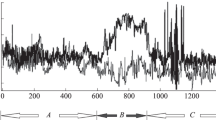Abstract
To explore the applicability of discrete wavelet transforms in the analysis of vHIT responses. Discrete wavelet transform was applied to vHIT responses and a new method for calculating aVOR gain was developed. A prospective study was performed with two groups of normal (N = 10) and altered (N = 19) gain values; HIMP and SHIMP vHIT protocols were performed on both groups. To evaluate the gain values obtained, Intraclass Correlation Index, Pearson’s correlation, linear regression, and t test were performed. Intraclass correlation indexes of 0.97 and 0.99 were determined for HIMP and SHIMP procedures performed on the proposed and standard gain calculation method. A significant difference of − 0.06 ± 0.07 (p < 0.001) was found between gain calculation methods for HIMP protocol. Significant differences were found (p < 0.001) between normal and altered groups for all gain calculation methods. Discrete wavelet transforms were successfully applied to measure head impulse test responses. Gain values obtained with this method appear to be valid and in concordance with gain values obtained with standard calculation method. However, a slight but significant difference was observed when this method was applied to tests obtained with HIMP.





Similar content being viewed by others
References
Halmagyi GM, Curthoys IS (1988) A clinical sign of canal paresis. Arch Neurol 45:737–739
Welgampola MS, Akdal G, Halmagyi GM (2017) Neuro-otology—some recent clinical advances. J Neurol 264:188–203
MacDougall HG, Weber KP, McGarvie LA, Halmagyi GM, Curthoys IS (2009) The video head impulse test: diagnostic accuracy in peripheral vestibulopathy. Neurology 73:1134–1141
Aw ST, Haslwanter T, Halmagyi GM, Curthoys IS, Yavor RA, Todd MJ (1996) Three-dimensional vector analysis of the human vestibuloocular reflex in response to high-acceleration head rotations. I. Responses in normal subjects. J Neurophysiol 76:4009–4020
Boleas-Aguirre M, Migliaccio AA, Carey JP (2007) Vestibulo-oculomotor reflex recording using the scleral search coil technique. Review of peripheral vestibular disorders. Acta Otorrinolaringol Esp 58:321–326
Macdougall HG, McGarvie LA, Halmagyi GM, Curthoys IS, Weber KP (2013) The video head impulse test (vHIT) detects vertical semicircular canal dysfunction. PLoS One 8:e61488
Mantokoudis G, Saber Tehrani AS, Kattah JC, Eibenberger K, Guede CI, Zee DS, Newman-Toker DE (2015) Quantifying the vestibulo-ocular reflex with video-oculography: nature and frequency of artifacts. Audiol Neurootol 20:39–50
Addison P (2002) The illustrated wavelet transform handbook: introductory theory and applications in science, engineering, medicine and finance. Institute of Physics Publishing, Bristol
Rey-Martinez J, Batuecas-Caletrio A, Matiño E, Perez Fernandez N (2015) HITCal: a software tool for analysis of video head impulse test responses. Acta Otolaryngol 135:886–894
Magosso E, Ursino M, Zaniboni A, Gardella E (2009) A wavelet-based energetic approach for the analysis of biomedical signals: application to the electroencephalogram and electro-oculogram. Appl Math Comput 207:42–62
Curthoys I, MacDougall H, McGarvie L, Weber K, Szmulewicz D, Manzari L, Burgess A (2016) Halmagyi G. In: Jacobson G, Shepard N (eds) Balance function assessment and management, 2nd edn. Plural Publishing, San Diego, pp 391–430
MacDougall HG, McGarvie LA, Halmagyi GM, Rogers SJ, Manzari L, Burgess AM, Curthoys IS, Weber KP (2016) A new saccadic indicator of peripheral vestibular function based on the video head impulse test. Neurology 87:410–418
McGarvie LA, MacDougall HG, Halmagyi GM, Burgess AM, Weber KP, Curthoys IS (2015) The video head impulse test (vHIT) of semicircular canal function—age-dependent normative values of VOR gain in healthy subjects. Front Neurol 8:154
Matiño-Soler E, Esteller-More E, Martin-Sanchez JC, Martinez-Sanchez JM, Perez-Fernandez N (2015) Normative data on angular vestibulo-ocular responses in the yaw axis measured using the video head impulse test. Otol Neurotol 36:466–471
Shrout PE, Fleiss JL (1979) Intraclass correlations: uses in assessing rater reliability. Psychol Bull 86:420–428
Koo TK, Li MY (2016) A guideline of selecting and reporting intraclass correlation coefficients for reliability research. J Chiropr Med 15:155–163
Bland JM, Altman DG (1986) Statistical methods for assessing agreement between two methods of clinical measurement. Lancet 8:307–310
Moore C, Mertens S (2011) The nature of computation. Oxford University Press, Oxford
Author information
Authors and Affiliations
Corresponding author
Ethics declarations
Funding
No funding was received.
Conflict of interest
The author declares no conflict of interest.
Ethical approval
Informed consent was obtained from all the patients. Because of no new or exceptional interventions, only local ethical committee (Hospital Quironsalud donostia ethical board) approval was required by the clinical researcher.
Statement of human rights
This clinical observational study was designed and performed in accordance with the ethical guidelines of the 1975 Declaration of Helsinki.
Electronic supplementary material
Below is the link to the electronic supplementary material.
Rights and permissions
About this article
Cite this article
Rey-Martinez, J. Validity of wavelet transforms for analysis of video head impulse test (vHIT) results. Eur Arch Otorhinolaryngol 274, 4241–4249 (2017). https://doi.org/10.1007/s00405-017-4755-9
Received:
Accepted:
Published:
Issue Date:
DOI: https://doi.org/10.1007/s00405-017-4755-9




